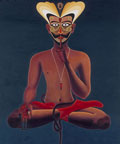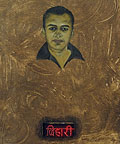Introduction

Surendran
Nair,
Mephistopheles....
Otherwise, the Quaquaversal Prolix (Cuckoonebulopolis), 2003 |
|
In the
spring of 2005, Asia Society and the Queens Museum of Art co-presented
the first-ever major exhibition of contemporary Indian art in the United
States. Co-organized by the Art Gallery of Western Australia, Edge
of Desire: Recent Art in India included 80 cutting-edge works of
sculpture, painting, drawing, installation, video and interactive media
dating from 1993 to the present. Works of internationally recognized
contemporary artists are shown alongside those of India’s most
innovative, emerging artists. The 38 participating artists and collectives
— representing three generations — live and work in their
native India, in urban centers as well as remote rural areas.
Edge
of Desire traverses conventional divides between urban, fine art
and folk tradition art, and between high culture and popular culture.
Reflecting a time of socio-political transformation in India, exhibition
artworks address contemporary political, social, and environmental realities
existing there.
“Edge
of Desire reflects contemporary Indian society’s constantly
shifting experiences of caste alliances, class structures, and global
trends in localized settings,” notes Asia Society President Vishakha
N. Desai. “To accompany this major exhibition, Asia Society has
organized India: The Future Is Now, a full slate of multidisciplinary
programming to examine these dynamic trends as well as aspects of India
that generally escape Western attention.”
| |

Atul
Dodiya
Tomb’s Day (detail),
2001 |
“The
artworks in Edge of Desire challenge preconceptions of contemporary
India, whose presence in Western culture is often limited to Bollywood,
yoga and outsourcing,” notes Asia Society Museum Director Melissa
Chiu. “This exhibition aims to do for contemporary Indian art
what Inside Out: New Chinese Art did in 1998 for raising awareness
of the vibrant art scene in China.”
“An
exhibition of the magnitude of Edge of Desire, filling the
galleries of both the Queens Museum of Art and the Asia Society, is
a tribute to the depth and diversity of contemporary Indian art as well
as to the shared goal of our institutions to engage New York in artistic
conversations with international visual culture," said Tom Finkelpearl,
Executive Director of the Queens Museum of Art. “This exhibition,
paired with our complementary offering, Fatal Love: South Asian
American Art Now, is a step in not only introducing South Asian
visual art to the international art scene, but in urging New Yorkers
to look closely at emerging communities here and now.”
Edge
of Desire is curated by Chaitanya Sambrani, Lecturer, Art Theory
Workshop, Australian National University, Canberra. The exhibition is
accompanied by a fully illustrated color catalogue with essays by leading
scholars, including Ashish Rajadhyaksha and Kajri Jain.
Participating
artists include: Ganga Devi Bhatt, Manu Chitrakar, Swarna Chitrakar,
Atul Dodiya, Shilpa Gupta, Subodh Gupta, Archana Hande, N.S. Harsha,
Rummana Hussain, Tushar Joag, Ranbir Kaleka, Ravi Kashi, Mallikarjun
Katakol, Sonia Khurana, Raj Kumar, Nalini Malani, Umesh Maddannahalli,
Kausik Mukhopadhyay, Pushpamala N. and Clare Arni, Surendran Nair, Open
Circle, Cyrus Oshidar/MTV India, Sudhir Patwardhan, Raqs Media Collective,
N.N. Rimzon, Sharmila Samant, Gulammohammed Sheikh, Nilima Sheikh, Nataraj
Sharma, Dayanita Singh, Subhash Singh Vyam, K.G. Subramanyan, Vivan
Sundaram, L.N. Tallur, Vasudha Thozhur, Santosh Kumar Das and Sonadhar
Vishwakarma.
The
exhibition

Swarna
Chitrakar,
Titanic, 2003 |
|
Edge
of Desire is organized around five themes—Location/Longing,
Unruly Visions, Transient Self, Contested Terrain and Recycled
Futures—with the first two on view at Asia Society and the
final three at the Queens Museum of Art. Works in Location/Longing
(on view at Asia Society) address the desire for place and the relationship
with locations real and imagined. Nilima Sheikh’s series of painted
scrolls (2003-04) made specifically for this exhibition, reference several
centuries of writing inspired by Kashmir in an extended meditation on
desire and loss.
Swarna
and Manu Chitrakar are members of a community of patua (scroll-maker)
painter-performers from West Bengal (the surname Chitrakar, meaning
painter, is a trade name that all painters from this community use).
Though their work tends to be characterized as folk art—implying
works that are decorative, even naïve and static in process—Manu
and Swarna draw on their traditions and skills to articulate responses
to contemporary life and events, as evidenced in Swarna’s scroll
Titanic (2003) based on the eponymous 2001 film and Manu’s
scroll Afghanistan War (2003).
Unruly
Visions (on view at Asia Society) is concerned with the artists’
relationships with the many guises of popular culture in contemporary
India: the visual culture of television, advertising, cinema and Bollywood,
and the unruly, mixed-up visions characterized by everyday life on the
street. Atul Dodiya’s triptych, Tomb’s Day (2001)
makes parodic references to one of India’s stereotypical icons,
the Taj Mahal. Executed in the visual style of billboard painting, the
work is in part an ironic commentary on the media furor surrounding
the visits to India by Presidents Clinton and Putin.
| |

Subodh
Gupta,
Bihari, 1999 |
The section
on Transient Self (on view at Queens Museum of Art) examines
migration and transience as major features of the contemporary Indian
experience. Works included under this theme range from personal histories
and realist commentaries to fabrications of self-transformation. Subodh
Gupta’s self-portrait, Bihari (1999) is a wry commentary
on the artist’s migration from his native Bihar to upwardly mobile
Gurgaon, in Delhi. In this work he uses cow dung to cover the painting
with an LED spelling out Bi-ha-ri, a person from Bihar but also a derogatory
term in India, implying uncouthness.
Contested
Terrain (on view at Queens Museum of Art) addresses the pressures
in contemporary Indian society spawned by globalization and religious
fundamentalism. Nalini Malani’s installation, The Sacred and
the Profane (1998) projects a play of shadows from images painted
in acrylic on large, rotating Mylar cylinders. Her work challenges notions
of separation and insularity. A series of works (2003) by the painter
Santosh Kumar Das responds to communal violence in Gujarat, referencing
a figurative tradition of Madhubani painting of juxtaposing recent events
with historical figures such as Mahatma Gandhi.
The section
on Recycled Futures (on view at Queens Museum of Art) encompasses
works that conflate regenerating materials and renewal of tradition,
and that are playful, often satirizing popular consumer culture. Sharmila
Samant’s work, A Handmade Saree (1998), is painstakingly
crafted from 1,800 Coca-Cola bottle caps fastened together with steel
shackles. Draped as in a boutique display, it reveals traditional textile
patterns such as mango motifs. On the floor, three framed texts provide
the formal meanings of the terms “handmade,” “saree”
and “coke.”
Another
exhibition highlight is L.N. Tallur’s large scale and brightly
colored, inflatable vinyl installation Made in England: A temple
designed for India (2000), which addresses the mania for shrines
and the search for spiritual roots. Viewer’s can enter the darkened
sanctum of this easily transportable temple.
Other
venues and dates
Edge of Desire opened at the Art Gallery of Western Australia,
Perth (Sept. 25, 2004 – Jan. 16, 2005) and travels to multiple
venues internationally including: Tamayo Museum, Mexico City (Aug. 18
– Nov. 20, 2005); Museum of Contemporary Art (MARCO); Monterrey,
Mexico (Nov. 2005 – Jan. 2006); final venue in India.
Edge
of Desire: Recent Art in India and related programs were made possible
with support from The Reliance Group, The Andy Warhol Foundation for
the Visual Arts, Inc., National Endowment for the Arts, MAP Fund, Purnendu
and Amita Chatterjee, Gita and Sonny Mehta, Arts International, Skadden,
Arps, Slate, Meagher & Flom LLP, and Sir Dorabji Tata Trust. Additional
support was provided by the Asia Society's India Fund, whose major donors
include Rohit and Katharine Desai, Tara and Victor Menezes, Harish Raghavan
and Ramaa Reddy Raghavan, Sribala Subramanian and Arvind Raghunathan,
Lakshmi and Sandy Chandra, John P. and Jennifer Clay, Dr. Angela Anand
Cobra and Dr. Suryanarayan Anand.

Asia
Society - March 1, 2005 – June 5, 2005
725 Park Avenue (at 70th Street), New York City
The Museum is open Tuesday through Sunday from 11:00 a.m. – 6:00
p.m., Friday from 11:00 a.m. to 9:00 p.m. Closed Monday. General admission
is $10, seniors $7, students $5 and free for members and persons under
16. Free admission Fridays, 6:00 to 9:00 p.m.

Queens
Museum of Art - February 27, 2005 – June 5, 2005
New York City Building, Flushing Meadows Corona Park, Queens
The Museum is open Wednesday through Friday from 10:00 p.m. to 5:00
p.m. and on Saturday and Sunday from 12:00 p.m. to 5:00 p.m. Admission
is by suggested donation: adults $5.00, senior and students $2.50, and
free for members and children under 5.
|

